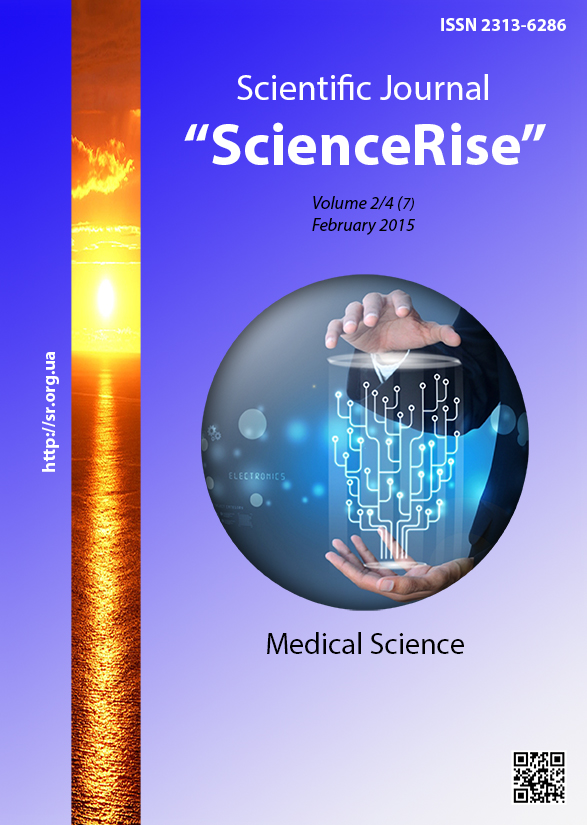Lactic acidosis in pediatric sepsis
DOI:
https://doi.org/10.15587/2313-8416.2015.37901Keywords:
children, sepsis, severe sepsis, septic shock, multiple organ dysfunction syndrome, lactate, nitric oxide, endothelin, microcirculation, hemodynamicsAbstract
Aim. To determine the leading mechanisms of lactic acidosis course it is conducted a detailed analysis of scientific papers on this issue, and on the basis of modern scientific basis to conduct the study of the state of hemodynamics, metabolism and acid-base balance in pediatric sepsis.
Methods. To achieve this aim it was used to identify indicators of central and organ hemodynamics by Doppler ultrasound, were studied the ABB indicators of central venous and arterial blood electrolytes, creatinine, urea, lactate, endothelin, serum metabolites of nitric oxide. SOFA and Glasgow scales are used.
Result. The results of the study gave reason to believe that lactic acidosis in pediatric sepsis is not caused by disorders of the central and organ (liver, mesenteric, renal) hemodynamics. Instead it is revealed the relationship between course of lactic acidosis and presence of hyperglycemia. A negative impact of lactic acidosis on the severity of multiple organ dysfunction syndrome (MODS) and outputs in pediatric sepsis is stated.
Conclusions. Thus, summing up the results obtained in the study, we conclude that hyper lactic acidosis in pediatric sepsis is an important marker for disorders of energy metabolism and an independent marker of unfavorable prognosis and a high risk of MODS.
References
Leverve, X., Mustafa, I. (2002). Lactate: A key metabolite in the intercellular metabolic interplay, 6, 284–285.
Marino, P. L. (2010). Intensivnaya therapia [The ICU Book]. GEOTAR-Media, 768.
Kostuchenko, S. S. (2009). Kislotno-shcelochny balans v intensivny therapiy [ABB in ICU]. Minsk, 175.
Dementeva, I. I. (2002). Klinicheskie aspekty sostoyaniya i regulatsii kislotn-osnovnogo gomeostasa [Clinical aspects of acid-base regulation]. Moscow, Russia: Unimed-press, 80.
Bridges, E., Dukes, M. (2005). Cardiovascular Aspects of Septic Shock. Critical Care Nurse, 25, 14–40.
Gore, D., Jahoor, F., Hibbert, J. (1996). Lactic acidosis during sepsis is related to increased pyruvate production, not deficitis in tissue oxygen availability. Annals of Surgery, 224 (1), 225–229. doi: 10.1097/00000658-199607000-00015
Marik, P., Raghavan, M. (2004). Stress-hyperglycemia, insulin and immunomodulation in sepsis, Intensive Care Medicine, 30 (5), 748–756. doi: 10.1007/s00134-004-2167-y
Maric, P. (2004). Monitoring theraputic interventions in critically ill septic patients, Nutrition in Clinical Practice, 19 (5), 423–432. doi: 10.1177/0115426504019005423
Morgan, G. E., Mikhail, M. S. (2010). Klinichesraya anestesiologia [Clinical anesthesiology]. Мoscow, S-t Pb, Russia: Binom-Nevsky Dialekt, 366.
Belebesiyev, G. I. (Ed.) (2008). Intensivnaya terapiy v pediatriy [Pediatric Critical Care]. Кiev: Мeditsina, 520.
Downloads
Published
Issue
Section
License
Copyright (c) 2015 Володимир Анатолійович Корсунов

This work is licensed under a Creative Commons Attribution 4.0 International License.
Our journal abides by the Creative Commons CC BY copyright rights and permissions for open access journals.
Authors, who are published in this journal, agree to the following conditions:
1. The authors reserve the right to authorship of the work and pass the first publication right of this work to the journal under the terms of a Creative Commons CC BY, which allows others to freely distribute the published research with the obligatory reference to the authors of the original work and the first publication of the work in this journal.
2. The authors have the right to conclude separate supplement agreements that relate to non-exclusive work distribution in the form in which it has been published by the journal (for example, to upload the work to the online storage of the journal or publish it as part of a monograph), provided that the reference to the first publication of the work in this journal is included.

